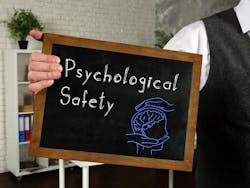Discussions on the efficacy and importance of DEI in the workplace have reached a fever pitch. While the conversations on DEI are partially centered on politics, there is a fair amount of soul-searching by companies about how important these policies are. However, from a safety standpoint—viewing DEI as the foundation of psychological safety—these policies stand up to scrutiny.
What is necessary is for companies to clearly understand the link between psychological safety and a safer workplace in general. There are many ways to link psychological safety to physical safety. One of the common measurements is in terms of engagement.
“Workers often feel they can trust [EHS] professionals to listen, offer support and advocate for them,” explained Kimberly Gamble, director of Andersen Construction’s Inclusion, Diversity, Equity, Advocacy and Leadership program, as part of a discussion on DEI facilitated by The American Society of Safety Professionals (ASSP). “With this trust, we can create teams that work collaboratively to not only improve physical safety but also psychological safety.”
ASSP has deemed DEI critical to occupational safety and health. In fact, in 2022, former president Christine Sullivan talked about the need for her organization to step up their game when it comes to this issue, when she observed, “Within ASSP, our goal is to create safe and welcoming environments where differences related to factors such as race, ethnicity, class, religion, age, sex, sexual orientation, gender identity, nationality, ability and education are not only accepted but celebrated. We want all stakeholders to be treated with respect and to know their voices are heard, particularly those who are often marginalized or silenced in other areas of their lives.”
Sullivan added, “As safety professionals, we protect a diverse workforce and we must understand how DEI concerns affect their performance and their safety.”
ISO Guidance for Mental Health
Taking this philosophy into the realm of standards, or best practices, ISO created standard for psychological health and safety at work: ISO 45003. The guidelines for managing psychosocial risks emphasize the critical importance for companies to eliminate hazards and minimize EHS risks by taking preventive and protective measures, including psychosocial risks. “Psychosocial hazards relate to how work is organized, social factors at work and aspects of the work environment, equipment and hazardous tasks,” the guidelines state. “Psychosocial hazards can be present in all organizations and sectors, and from all kinds of work tasks, equipment and employment arrangements.”
The guidelines note that negative outcomes for workers can include “poor health and associated conditions (e.g., cardiovascular disease, musculoskeletal disorders, diabetes, anxiety, depression, sleep disorders) and associated poor health behaviors (e.g., substance misuse, unhealthy eating), as well as reduced job satisfaction, commitment and productivity. Managing psychosocial risks can result in positive outcomes, including improved job satisfaction and increased productivity.”
And the impact to companies of failing to manage psychosocial risks includes “increased costs due to absence from work, turnover, reduced product or service quality, recruitment and training, workplace investigations and litigation, as well as damage to the organization’s reputation.”
Building Inclusion
As ISO 45003 details, psychosocial hazards can take a variety of forms. “We need to better understand how incivility, workplace bullying, and a lack of psychological safety can negatively impact workplace safety,” said Andersen Construction’s Kimberly Gamble. “These are topics I wish I had known more about when working full time in construction safety.”
Gamble references Georgetown University’s Christine Porath, who says that incivility at work can cause a person to be less committed to their work and more likely to avoid the offender. “It can also cause an individual to lose focus, retain less information and make more errors—all potential contributing causes to incidents. I recall two serious incidents from my 26 years working in construction safety. Had I known then what I know now about inclusion and belonging, I would have embedded civility and psychological safety evaluations into the incident investigation processes because uncivil behavior was a contributing cause.”
Another avenue to ensure psychological safety is to understand the concept of unconscious bias. “When an employee does not have the burden of bias, and feels psychologically safe, they are able to contribute at an optimal level,” says Buki Mosaku, an international expert on effective communication and workplace bias and founder of DiverseCity Think Tank.
Dealing with the root cause of bias begins with understanding that bias is a two-way street. “An employee can have as much bias toward a manager as the manager has toward the employee,” says Mosaku. The two types of bias are directional and reverse. Directional is what you feel is aimed at your race, religion, gender, etc. Reverse is your bias in how you interpret what is happening. Whatever form this bias takes, he says that it must be understood, called out and corrected.
One way to correct this bias is through the use of technology, specifically artificial intelligence, says Tim Glowa, founder and CEO of HRbrain.ai. “The advantage of far-reaching technology like AI is that it is able to analyze a great deal of data in a short period of time.”
Glowa uses AI to help companies assess a variety of sources against 15 different corporate culture dimensions, including DEI, leadership and ethics, and come up with an overall metric which classifies a company on the spectrum between toxic and high performing. Once a company has a baseline it can review if there are any biases that are contributing to a less-than-ideal culture.
“Looking across all forms of communication, such as training documents as well as job descriptions, we can identify words that unconsciously make employees feel uncomfortable,” Glowa notes. “There might be unconscious gender, ethnic, or cultural biases in particular word choices.”
Gamble agrees that inclusion is key, and her company’s program is built on it. “By focusing on [inclusion] first, we work to bring people together, then create brave learning spaces. In these learning spaces, we have hosted DEI consultants, trainers and people of diverse lived experiences to lead sessions on implicit bias, Black history, Native American history, Hispanic and Latino history, and critical race theory in design. We also have introduced a program with a focus on the construction industry’s history and demographics, sharing research data that demonstrates why we lose so many apprentices—particularly women and people of color—and the threat this poses for our industry. We address behaviors that harm and introduce bystander intervention and psychological safety.”
The process of understating psychological safety and implementing programs which will create a safe work environment is a continual process. “DEI initiatives are not a one-time fix,” Sullivan observed. “As safety professionals, we should do something each day to move the needle on DEI to improve our companies. Working together, we will not only create a safer, stronger future, we will also nurture a culture in which we all embrace opportunities to learn and grow so everyone can excel.”
About the Author
Adrienne Selko
Senior Editor
Email [email protected]
Adrienne Selko is also the senior editor at Material Handling and Logistics and is a former editor of IndustryWeek.

